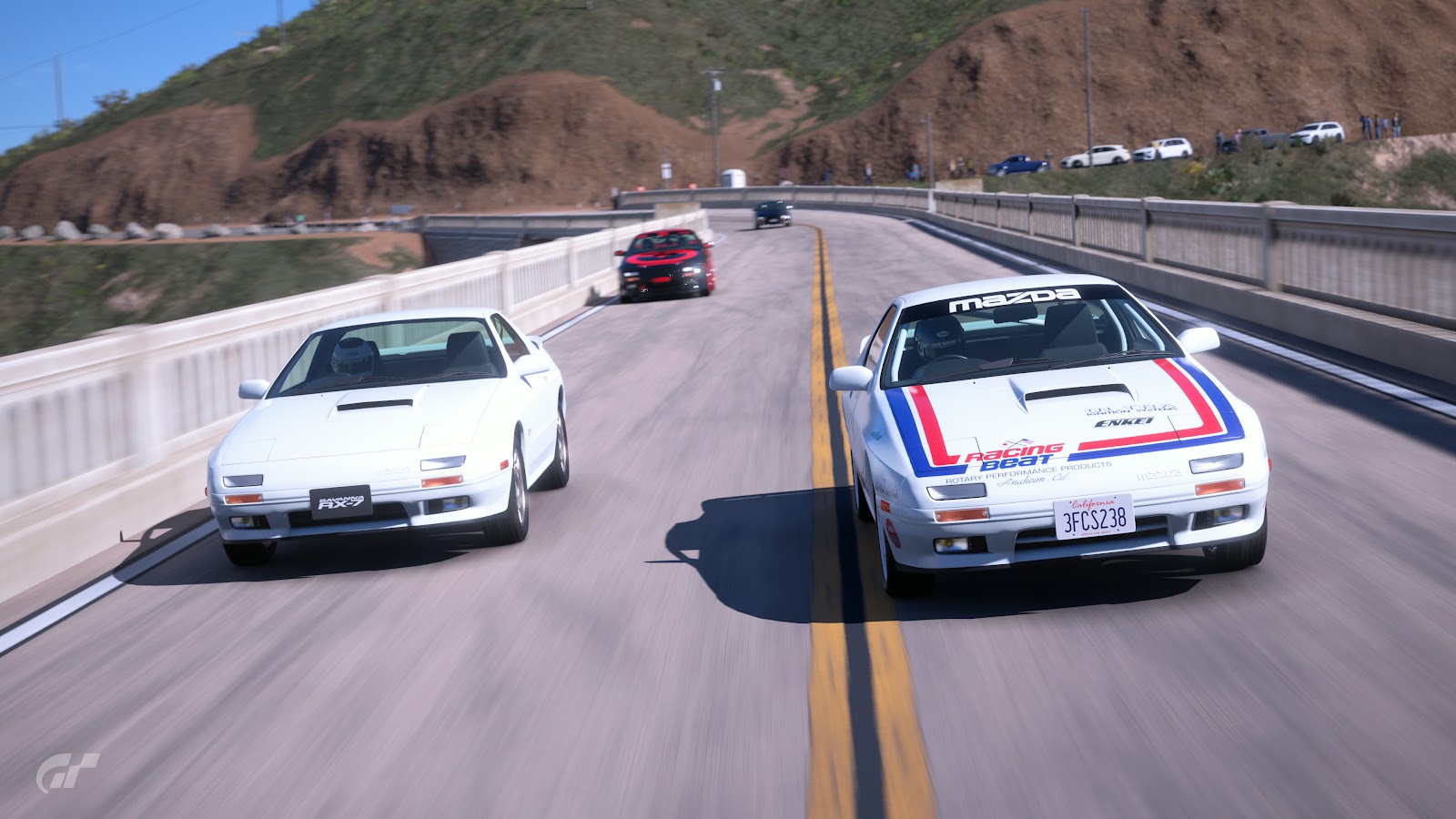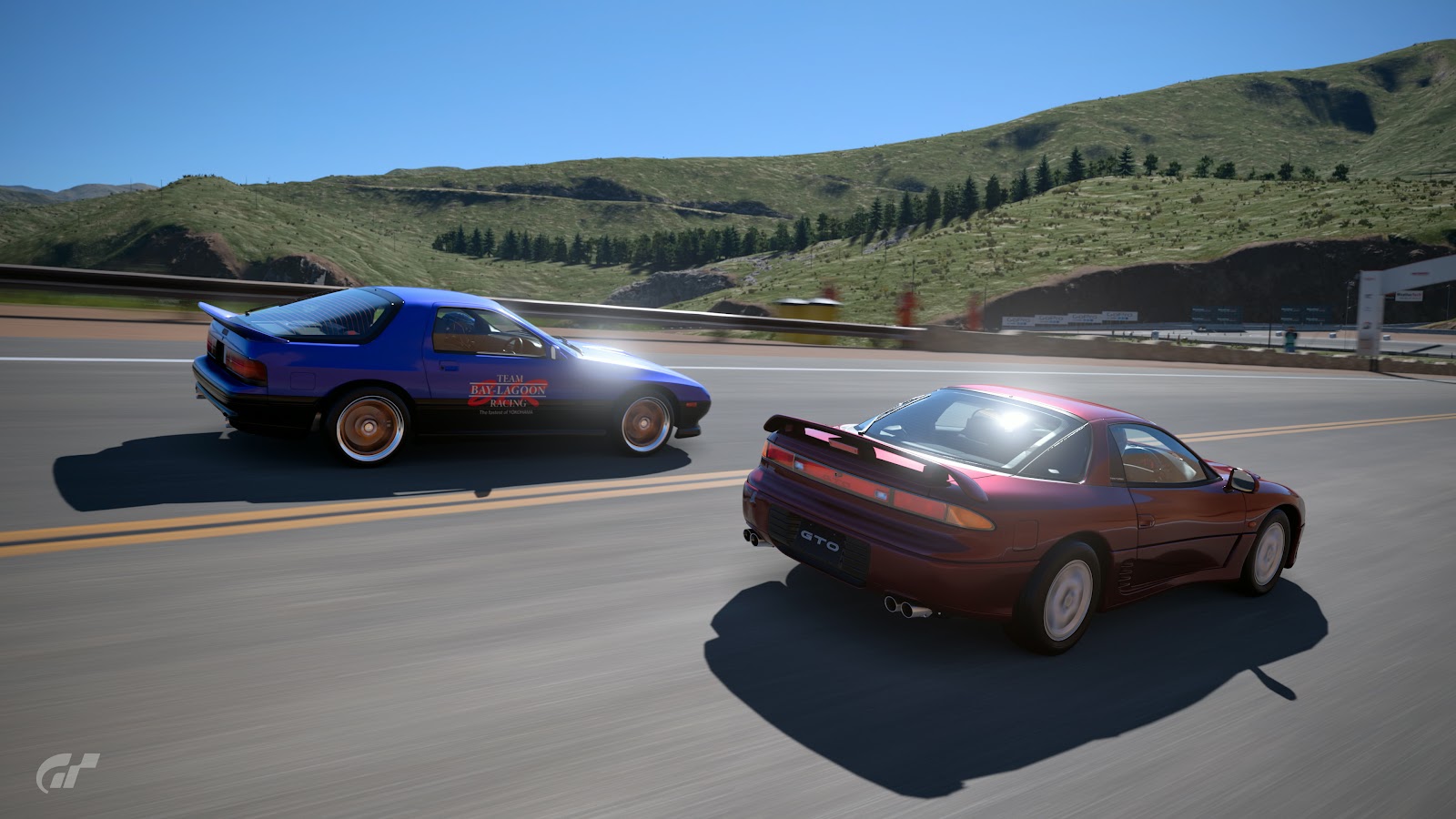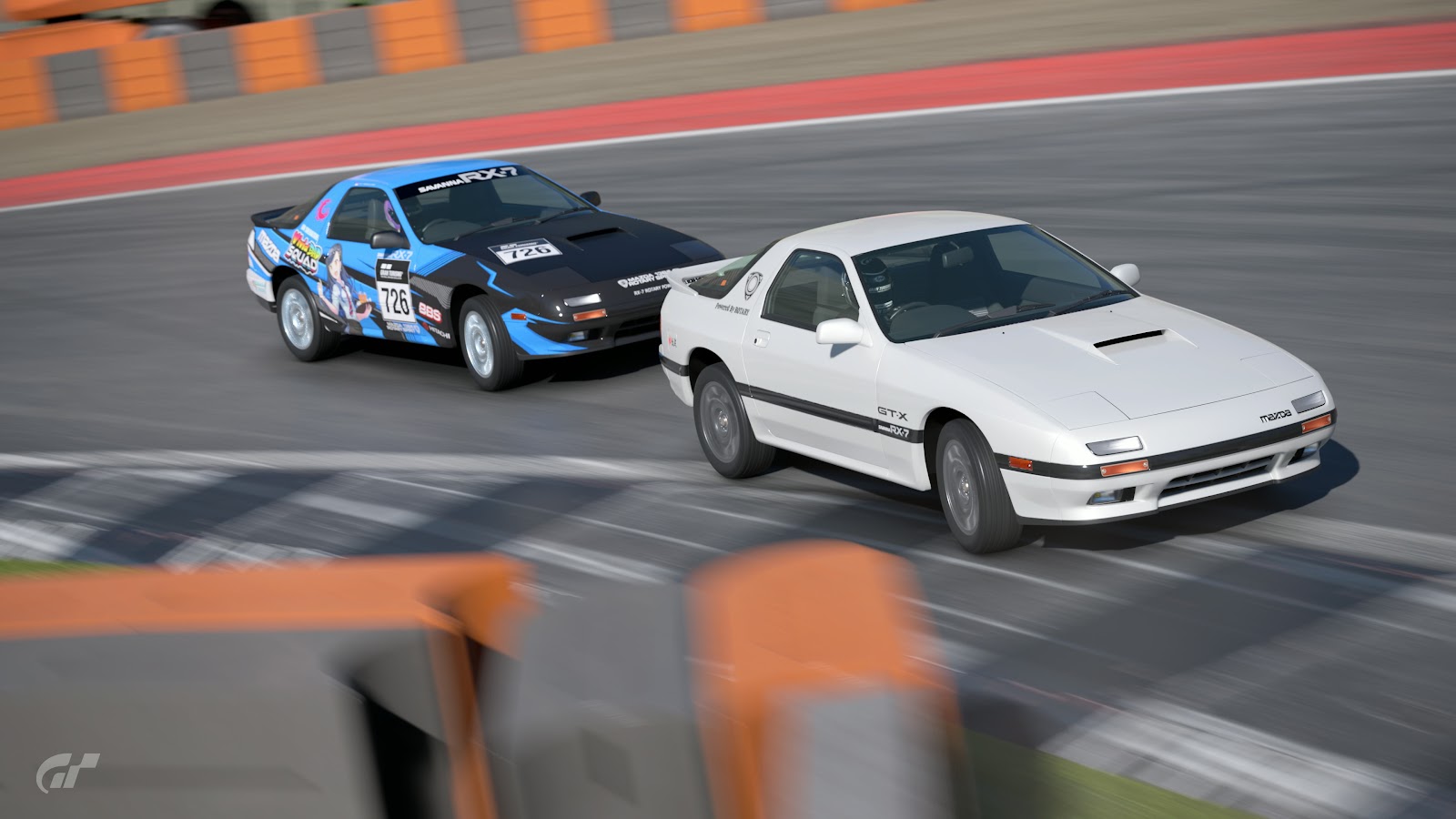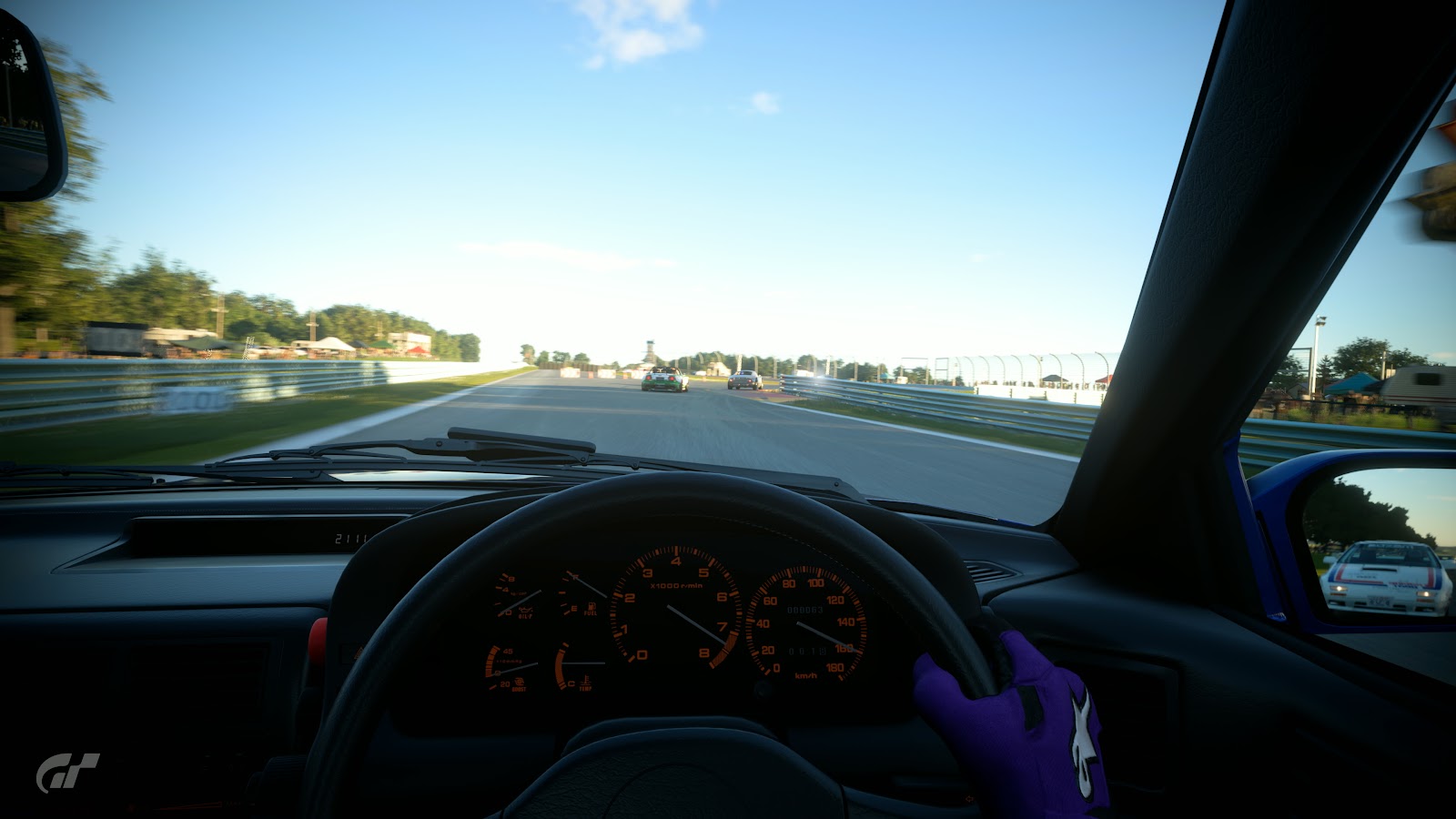"By the time the second–generation RX-7, the FC3S, arrived in October 1985, Mazda had firmly established the model as a competent rotary–powered sports machine", says the in–game description of the RX-7 GT-X. So, if the first generation was a success critically and commercially, what would Mazda do as a follow–up act? Why, change it, of course!
While the first generation SA22C (and later FB3S) RX-7s were cheap, fun, lightweight and peppy sports cars that sold like hotcakes, Mazda, wanting a bigger slice of the American market pie, decided to sweeten up the follow–up with about 200 kilos of saturated grand touring fat. Ironically for a company known for innovation and marching to the beat of their own drum, Mazda had decided that the best way to do market research into what Americans wanted was to copy the Germans almost wholesale; even someone like me who has spent the most of his life ogling at RX-7s has to do a double take when I see a 924 or FC on the road. All told, the FC not only suffers from being the middle child among the trifecta, but also one that seems the most ungainly, seemingly sharing less with its much better regarded siblings and more with a car that Volkswagen wanted nothing to do with.
However, one area in which Mazda (thankfully) didn't copy from Germany was the price. This is especially true in Japan, where the boxy silhouette of the FC seemed almost like a deliberate effort to squeeze as much car into the compact car class as Mazda could, with the width of the FC measuring in just one centimetre under the class limit. Coupled with the 13B two rotor engine officially displacing just 1,308cc, the FC, even with its added bloat and heft, slid smug into the lower tax bracket of the compact car class. In other words, the FC RX-7 offered not only a step up in creature comforts, but also Porsche rivaling performance on a base that begged to be modded to high heaven, all for a moderate asking and running price.
And hoo boy, did people mod these things. Racing Beat set a BGT record at the Bonneville Speed Week with an FC RX-7, hitting 238.4mph (383km/h) on the salt flats. Rob Millen fielded a 3 Rotor, 790kg, AWD beast of an FC up Pikes Peak in 1987. A 4–Rotor FC took both driver's and manufacturer's championships in 1990 and 1991 at Daytona, along with many class wins along the way. And if shenanigans in Gran Turismo games count, used FCs are cheap enough to be had as one's first car for under the starting 10k Credits in the PS1 era games, which is exactly how my journey started, actually! I remember tuning mine to shoo FDs off the track, and even to this day, I have a soft spot for a clean example of Blaze Red FCs because, quite simply put, I wouldn't be the person I am today if it weren't for that car. In case it needed spelling out, that's exactly why I wanted to start off GT7's Car of the Week with an FC RX-7.
But, that is not to say that this is my first experience with the FC in Car of the Week—Back when we tested this car in GT Sport, I loathed it! It had no grip, no power, and had heinously nervous handling without even being near its limits. Here in GT7, the FC is thankfully, a lot more stable and predictable, almost as if Polyphony Digital forgot to model in the idiosyncratic behaviour of the car's infamous Dynamic Tracking Suspension System. What's that, you ask? Well, not much is known about it, because when I Google "Mazda RX-7 DTSS", the first few results are always along the lines of, "how do I get rid of DTSS?". Supposedly, it's a system that gives the rear wheels some steering angle to "help" the driver, and... *whiff whiff* wait a minute, why does it smell like Porsche in here? And not just 1980s Porsches, either, but like... 2013 918 kinds of smell. Remind me again why my 24,860 Credit list price 80s Mazda smells like that?
Without that primitive and intrusive 80s tech meddling with the car, the FC's balance and neutrality finally takes centre stage in the driving experience. Capitalising on the Wankel Rotary Engine's unique compactness, the entirety of the ornate powerplant is situated well behind the front axle and right up against the firewall, making this car technically mid engined. What this results in is a remarkable 52/48 F/R weight distribution, and when behind the wheel, the car's 1,250kg (2,756lbs) kerb mass doesn't feel like it was concentrated in any one area; the whole thing feels very proportionate and effortless to maneuver when still within the limits of grip. That, uh... doesn't happen very often in the twisties.
Being a high grade turbo model, the GT-X not only comes with ABS as standard, but is also shod with upsized 205mm tyres all four corners, and oof, after driving this top grade turbo trim, I shudder at the thought of the non turbo variants coming with no ABS and 185mm tyres. I don't think Gran Turismo simulates old tyres, but the FC has the uncanny ability to make its default Comfort Soft tyres feel old. Trail brake into a corner, and the skinny tyres give up without much provocation or warning, and if you tried to force the issue, the unladen rear end is similarly happy to let loose with oversteer. In other words, this car can go from grip to 4 wheel slip in mere moments, all without the aid of the handbrake. You'd think that 203HP (151kW) and 269.7N⋅m (198.8lbf⋅ft) wouldn't even be enough to carry a bag of apex seals home, but even at middling rev ranges, the rather gutless feeling 13B Turbo can still give the rear tyres more than they can handle, even on a dry, paved racing circuit in 2nd.
Despite being one of the best starter car buys in the earlier Gran Turismo games, this car suffers massively on these classic tracks, now that they've become ultra wide and high speed affairs. Having to dive across the wide widths of these circuits just to find an apex fishes for understeer from the front end, and the wedge shaped car with a short deck is—surprise surprise—not that stable at high speed. I mean, this is a car with a hole drilled into its rear wing to accommodate a radio antenna, what else needs to be said or shown? At speeds above mid fourth gear, weight transfer is extremely snappy and unsettling, which can very easily result in a complete spin at high speed sections of circuits if one isn't careful and gentle with the car. This holds doubly true if braking for these high speed turns is involved, such as Turns 2 and 6 of High Speed Ring, and the Inner Loop at Watkins Glen.
Where this car excels and truly comes alive instead is at low to mid speed tracks, where its lightness, balance, and even its slight tail happiness can truly shine, although such tracks are excruciatingly rare in Gran Turismo 7. When I finally came across these select ribbons of asphalt though, it feels like I had finally found Nirvana. Like I had been arguing and fighting a family member for so long, and now I finally see where they're coming from and why they're acting the way they were. Such ribbons of enlightenment include the mountains of Bathurst for example, or just the whole of Tsukuba and Road Atlanta. At these tracks, the FC displays impeccable point and shoot capabilities, diving for apexes with enough vigor to bring out the rear end for a hint of slip. It can be driven on the limit that way for the fastest lap times, but the fragile balance and low grip of the car also means that the car is only very light encouragement away from breaking all hell loose if you so wish or are careless, and the car remains a talkative tool even under all that duress. Propped up on soft, sky scraping springs with 150mm (5.91in) ground clearance, kerbs and sausages are no less parts of the track to be exploited as the parts paved by asphalt, allowing heinous corner cuts that would send stiffer sprung cars flying, and the one advantage of skinny tyres on the track is that one doesn't feel adverse camber in corners that much. In other words, the worse the road conditions are, the brighter the FC seems to shine.
Of course, no discussion about a Wankel powered car is complete without mention of said novel engine. While simple and elegant with few moving parts from an engineering standpoint, Rotary Engines are inherently peaky engines because of said simplicity, as engineers can't play with valve timings or bore and stroke to squeeze more low end torque out of them. This leaves turbocharging as the only means to breathe some semblance of life into the mid range, which is the approach Mazda have seemingly taken with the turbo models of the FC. One probably wouldn't come to that conclusion looking at where the engine makes peak power, though! With peak power happening only at rev ranges where most sensible cars would have long since tapped out—7,000rpm—the blown Wankel still makes you work to keep it screaming to give the most satisfaction. However, the plot twist here is in peak torque, as that occurs at a rev range even a diesel Demio can easily achieve: 3,500rpm! With peak power at 7 and peak torque at 3,5, one could almost park a Mazda Bongo bus in the gulf between peak torque and peak power!
Something tells me this isn't going to be the last time this white FC gets chased by a blue car...
In fact, the only thing noteworthy about the drivetrain isn't even the drivetrain, but rather, the beeper in the cabin that sounds to remind drivers to upshift. The idea is that, because Rotary Engines run so smoothly, it might be hard to discern its audio cues and know when to shift. I can't say I understand the need, but maybe it's a problem more prominent in real life. Here in the virtual world, though, the beeping is just bloody annoying!
They say you can't hear images, but those people have clearly never driven an FC RX-7.
Not only does the beeper itself sound like a 1980s alarm clock passing gas into a soiled diaper, but the beep itself comes on more than a whole thousand revs before fuel cut, from 6,800rpm. The astute among you might have quickly realised is where you'll want to spend most of your time on the track. I don't care if you're a devout saint, a compassionate mental health professional, or a tough secret agent trained to resist torture; everyone will lose their goddamn minds after 24 prolonged, agonising, infuriating seconds of the car beeping at you almost nonstop when taking a series of high speed bends that just so happens to require you camping in the last 1,200rpms of the rev range, such as the Back Straight, Inner Loop, Outer Loop, and Chute of Watkins Glen in succession. As for me, I find myself channeling my inner Tsunoda Yuki as I shout, "Yeah, I know, I'm doing! Stop talking to me, I'm in the braking zone! Don't talk to me anymore. Fucking engine brake!" The beeper only gets more infuriating if you do decide to tune your car, because the beeper isn't recalibrated to come on any later even if you shift the powerband later into the rev range and increase the rev limit. Oh, and here in GT7, Polyphony decided that we bumper cam players shan't be spared that immersion, and now that beep is also simulated in bumper cam in addition to cockpit cam!
All this effort for the beeper, and they still can't make the turbo boost pressure gauge in the cockpit work after 13 years?! It hasn't worked since the cockpit of the car was first rendered in Gran Turismo 5, released in 2010! At this point, I'm starting to think that the boost gauge in the real car that PD scans is broken, and they didn't bother telling the owners about it!
The turbo RX-7 may be the faster version of Mazda's fast car, but how fast is it compared to everything else? Sadly, we don't have any variant of the 924 in the game to test, and of course a contemporary 911 would wallop it. Same with the A70 Supra or a Z32 Fairlady. Despite having marginally worse power and mass figures, the FC is only a split hair slower than the "base" E30 M3. As for the cars the FC is faster than... not much, really. It'd outrun an S13 and an AE86 for sure, but I much prefer the driving dynamics of those cheaper and lighter cars. But there's a theme developing here: the FC isn't going to be outgunned by anything with a cheaper list price than it, and it'd even give much more expensive cars a run for their money. In other words, the FC is an impeccable all rounder for a bargain price, and it's arguably a ton more fun than many of the cars I've listed above. Running the FC against so many wildcard cars this week, I think I've finally come to see that, in spite of its added bloat and heft, the FC3S RX-7 is nonetheless, a world class sports car for its time.
The FC is very much a product of its time, and it doesn't try to hide it any; it demands of its driver to be very gentle and measured in how they drive, as the car quickly gives out quickly to ham fisted maneuvers. It has to be steered gently. Eased into its pedals. The driver has to be cognizant of where its weight is at all times. Listen for and feel the tyres approaching their limits and letting go. While I usually am wont to say that cars like that are good for beginners to learn how to drive quick, the FC is a bit too fast and much too hazardous for that. On the contrary, I think it's a good car to force a seasoned racing driver to get reacclimitised to the mortality of a road car—during race day, I have had the car bite me back massively for what I had thought were reasonable asks, such as jabbing the brake pedal hard in a slightly off neutral braking zone into the final turn of High Speed Ring, only to snap the wheel hard left suddenly. Moments like that made me realise how conditioned I was to just bash and abuse bespoke, hardcore racing cars, and in turn, contextualise what I was asking for them and their capability to deliver without even showing signs of duress. You could say that the driving experience of an FC RX-7 brings a driver back to the fundamentals and basics, almost like coming across a primary school textbook as an adult during spring cleaning. It makes me go, "Oh wow, I used to do complicated math so slowly. I used to show all my work, draw all these diagrams and tables to solve an asinine problem no one would have... now I'll just use a calculator or outsource the problem". In the FC, it's, "Oh wow, cars used to be so much more mortal and unforgiving. I used to have to be so careful around even this slow car. Now it's all stiff springs, fat tyres, instant low down torque, and hand holding understeer". You could say that, after all these years desensitised by supercars and racing machines, driving the FC again made me more mechanically sympathetic. It reminds me of where I came from, and I have a very funny feeling that I'd feel this way driving this car today even if I hadn't started my Gran Turismo journey with one. And hey, on the dawn of a new set of physics, a set that is, in my opinion, the best yet in Gran Turismo by a long shot, the FC is a fantastic grounding experience to set me straight... by going sideways on me. A lot.















No comments:
Post a Comment